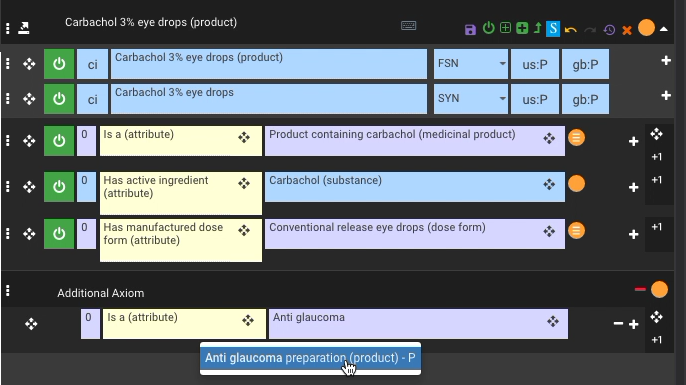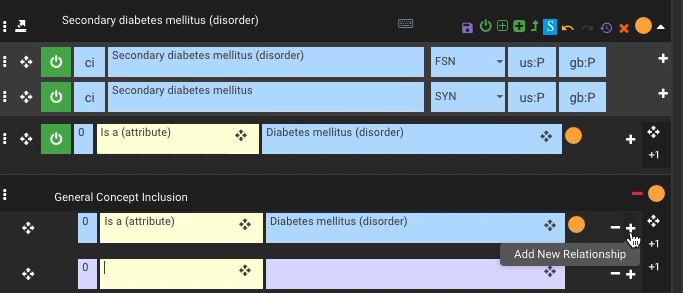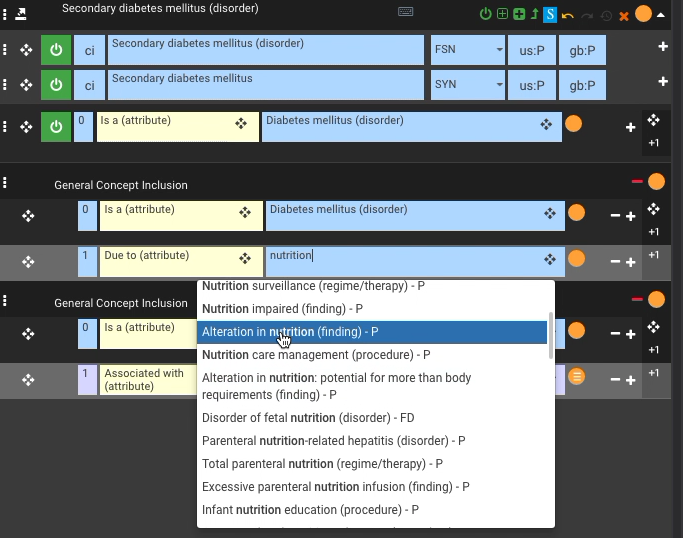- Created by Steve Archbold, last modified on 2018-Sep-04
DL features in the concept edit panel (Additional Axiom and General Concept Inclusion)
How do I add an Additional Axiom?
| Steps | Reference |
|---|---|
Open a concept for editing - for example: |
|
Press the |
|
Use type-ahead search (or drag and drop from the search or taxonomy panels) to enter and select a target for the Is a attribute. |
 |
Save the concept in the edit panel. |
|
View the saved concept with the new additional axiom. Note that the default Inferred view diagram does not change. |
|
| Switch the concept diagram to show the Stated view. Note the presence of the new additional axiom. |
|
How do I add a General Concept Inclusion?
| Steps | Reference |
|---|---|
Open a concept for editing - example: Secondary diabetes mellitus (disorder). The concept header contains the |
|
Press the |
 |
Drag parent Diabetes mellitus (disorder) as a target for the GCI Is a relationship. |
 |
Press the Add New Relationship "plus" button within the GCI panel. Use type-ahead search to enter and select Due to (attribute) as the relationship type. |
|
Use type-ahead search to enter and select |
|
| Save the concept. |
|
| Show the stated view of the concept diagram. Diagram shows empty GCI box with reverse subtype indicator. |
|
How do I modify a General Concept Inclusion?
| Steps | Reference |
|---|---|
With a GCI present in the concept edit panel (eg via the steps above), use the Add GCI Axiom button in the concept header to add a new GCI to the edit panel. Drag and drop the concept parent Diabetes mellitus (disorder) as the target for the new GCI Is a relationship. |
|
Using the Add General Concept Inclusion button in the concept header, add another GCI to the concept edit panel. | |
Press the Add New Relationship "plus" button within the GCI panel to add a new relationship. Use type-ahead search to enter and select Associated with (attribute) as the relationship type. |  |
Use type-ahead search to enter and select (for instance) Disorder of endocrine system (disorder)as the target value for the new Associated with relationship. |
|
Save the new GCI via the concept header Save Concept button. |
|
Modify the original GCI, for example using type-ahead search to find and select Alteration in nutrition (finding) as a new target for the Due to attribute. |
|
Press Save in the concept header to save the GCI attribute changes. |
|
Confirm the changes via the Stated view of the concept diagram. |
|
What is Description Logic?
Description Logics (DLs) exist to enable a reduction in content maintenance costs with a concurrent increase in content quality. Processing power and reasoning algorithms have improved such that a more expressive DL is now practical to use in SNOMED CT.
The principle benefit of more DL features is the ability to represent content in a more fully systematised and thus more machine processable way, to enable the following benefits:
increased efficiency, consistency, precision and quality of authoring through reduced manual effort to organise content
lower costs to author and maintain content through reduced manual effort
a more complete and consistent product that is, as a consequence, more usable (for implementers and end users) and attractive (to drive adoption and implementation)
reduction in the cost of assessing the impact of modelling change, because changes also become systematically describable (and transformable).
simplification of content modelling by removing workarounds
close interoperability with an international standard, OWL, allowing easier application of other standards and tools
explicitly specified logic profile for Description Logic features used in SNOMED CT
Transitive and Reflexive Properties
Attribute concepts now have the ability to declare DL property characteristics as Transitive or Reflexive.
Property characteristics are currently maintained via the Terminology Server Application Programming Interface (TS API). Changes can be made via service requests to the technical team.
{
"effectiveTime": "20110131",
"moduleId": "900000000000012004",
"active": true,
"released": true,
"conceptId": "123005000",
"fsn": "Part of (attribute)",
"definitionStatus": "PRIMITIVE",
"preferredSynonym": "Is a",
"propertyCharacteristics": ["Transitive"],
"descriptions": [],
"relationships": [],
"isLeafStated": true,
"isLeafInferred": true
}
When saved via the TS API, the changes are written into the Owl Axiom Reference Set as shown in the following examples:
moduleId | refsetId | referencedComponentId | OWLExpression |
|---|---|---|---|
| 900000000000012004 | 733073007 | 116680003 | TransitiveObjectProperty(sct:116680003) |
| 900000000000012004 | 733073007 | 733928003 | ReflexiveObjectProperty(sct:733928003) |
| 900000000000012004 | 733073007 | 733928003 | TransitiveObjectProperty(sct:733928003) |
Property Chains
OWL DL Property Chains can now be used within the authoring platform to infer additional concept properties during classification.
These inferred attributes appear in classification results along with all other inferred relationships.
Property chains are currently maintained via the TS API. Changes can be made via service requests to the technical team.
This feature allows |Has active ingredient| to be linked with |Is modification of|such that a medicinal product that has an active ingredient which is the modification of another substance, could classify as a child of a product containing the less modified substance.
This behaviour is critical to controlling the effect of changes to the |Substance (substance)| hierarchy on other hierarchies.
Additional Axioms
Additional Axioms are a new part of SNOMED CT concepts. Each Additional Axiom is like another mini concept definition including definition status and a set of stated relationships. These are presented and maintained through the concept edit panel in the same way as stated relationships, visually located below the existing stated relationships of the concept. Axioms have a named concept on the left and an expression on the right.
The relationships within each additional axiom follow MRCM rules just like the stated relationships. At least one is-a relationship is required in an axiom. The concept editor panel supports creation, editing and removing of axiom relationships. There is no released or active state on axiom relationships - they can always be modified or deleted.
Each axiom of a concept is necessarily true. The attributes from all axioms are in the inferred form and are inherited by children through inference. The normal form process may reduce these attributes if a more specific attribute or group of attribute is present, in the same way that is does for attributes from the stated relationships. Attributes in an additional axiom are inferred on the named concept and its descendants.
Concept A has axiom A1 (stated relationships) and A2.
Concept B has axiom B1 (stated relationships).
Concept A subsumes Concept B - Concept B gets the inferred attributes of axiom A1 AND A2.
General Concept Inclusion Axioms
Non-attribute concepts have the ability to declare general class axioms in addition to the stated relationships.
General Concept Inclusions (GCIs) with additional axioms provide authors with greater flexibility in how concepts are defined, and provide classifiers with a greater ability to make appropriate inferences.
For example, these features can be used to state that a subset of attributes is sufficient to define a concept, and therefore that this sufficient set can be used to classify other concepts as descendants in the hierarchy.
Each GCI is recorded as a separate axiom expression within a separate member of the Owl Axiom Reference Set. A GCI has a definition status which is represented using a SubClassOf or EquivalentClasses axiom expression.

Further Reading
Description Logic Enhancements - Briefing Paper
https://www.w3.org/TR/owl2-syntax/#Property_Hierarchy_and_Simple_Object_Property_Expressions
- No labels



















